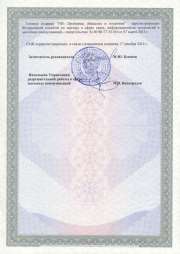|
MAIN PAGE
> Back to contents
History magazine - researches
Reference:
Shpirko S., Barankova G.
On Some Aspects of the Establishment of a Formal Genealogical Classification of Text Lists of Medieval Compositions Using the Theory of Fuzzy Sets (on the Material of “Zakon Sudnyi Liudem”)
// History magazine - researches.
2017. № 1.
P. 56-64.
DOI: 10.7256/2454-0609.2017.1.21194 URL: https://en.nbpublish.com/library_read_article.php?id=21194
О некоторых аспектах построения формализованной генеалогической классификации текстов списков средневекового произведения с применением теории нечетких множеств (на материале "Закона Судного людем")
Shpirko Sergey
Associate Professor, Moscow State Historical Archives Institute, Russian State University for the Humanities
119313, Russia, g. Moscow, ul. Leninskii Prospekt, 88 korpus 3, kv. 122

|
shpirkos@mail.ru
|
|
 |
Other publications by this author
|
|
|
Barankova Galina
PhD in Philology
BARANKOVA Galina Serafimovna – Senior Research Associate, V. V. Vinogradov Institute of Russian Language of the Russian Academy of Sciences;
Kaliningradskaya ulitsa 17/2 apt. 278, Korolev, Moskovskaya oblast’ 141076 Russia
141076, Russia, Moskovskaya oblast', g. Korolev, ul. Kaliningradskaya, 17 korpus 2, kv. 278

|
barankova@inbox.ru
|
|
 |
Other publications by this author
|
|
|
DOI: 10.7256/2454-0609.2017.1.21194
Received:
23-11-2016
Published:
19-03-2017
Abstract:
The article examines the issue of the genealogical classification preserved in the copies of Medieval texts. For its understanding the authors propose an approach based on the use of the theory of fuzzy sets. This approach utilizes the matrix of the fuzzy preference relation, which is founded on the pairwise comparison of the lists with each other. Each element of this matrix is the summation of its components, whose value is determined by the end set of different value factors (types of lection). These factors are considered in their total sum in the form of weight coefficients, which are determined through expert means. In order to eliminate the unavoidable subjectivity in evaluating them, the authors of this work developed an indirect method of expertise. The aim of the proposed method lies in that the given factors are compared pairwise in their value with each other. This way the initial complex problem is substituted by the entirety of more simple ones. Meanwhile the experts operate not with quantitative, but qualitative evaluations. The proposed new approach of expert evaluation allows in a formal way to assess the value of one or another discrepancy in the text. Thus the use of the proposed method plays a key role in the fuzzy classification of the list of Medieval compositions (establishing a genealogical stemming). The use of the examined method is illustrated on a specific example of discrepancy typology.
Keywords:
indirect expert method, theory of fuzzy sets, typology, stemmatology, weight coefficients, function of accessory, fuzzy relation matrix, typologyafuzzy classification, discrepancies, text analysis
References
1. Colwell E.C. and Tune E.W. The quantitative relationship between MS text-types// Biblical and patristic studies in memory of R.P.Casey/ Ed. by J.N.Birdsall and P.W.Thomson. Freiburg, 1963. P.25-32.
2. Alekseev A.A. Tekstologiya slavyanskoi biblii. Spb., 1999. 190 s.
3. Mandel' I.D. Klasternyi analiz. M., 1988. 176 s.
4. Borodkin L.I., Morozova L.E. Opyt ispol'zovaniya matematicheskikh modelei i EVM v tekstologicheskikh issledovaniyakh// Kolichestvennye metody v gumanitarnykh naukakh. M., 1961. 206 s.
5. Basaker R., Saati T. Konechnye grafy i seti. M., 1974. 368 s.
6. Zade L. Ponyatie lingvisticheskoi peremennoi i ego primenenie k prinyatiyu priblizhennykh reshenii. M., 1976. 165 s.
7. Shpirko S.V. Primenenie teorii nechetkikh mnozhestv k zadache genealogicheskoi klassifikatsii v tekstologicheskom issledovanii// Istoricheskaya informatika: Informatsionnye tekhnologii i matematicheskie metody v istoricheskikh issledovaniyakh. Barnaul, 2013. № 3. S. 39-51.
8. Likhachev D.S. Tekstologiya. M.-L., 1983. 640 s.
9. Zakon Sudnyi lyudem kratkoi redaktsii// Tikhomirov M.N., Milov L.V. M.,1961. 177 s.
10. Maksimovich K.A. Zakon Sudnyi lyudem. Istochnikovedcheskie i lingvisticheskie aspekty issledovaniya slavyanskogo yuridicheskogo pamyatnika. M., 2004. 240 s.
11. Sverdlov M.B. Stanovlenie feodalizma v slavyanskikh stranakh. SPb., 1997. 324 s.
12. Shchapov Ya.N. Vizantiiskaya Ekloga zakonov v russkoi pis'mennoi traditsii. SPb., 2011. 240 S.
13. Vasica J. Zakon'' sudnyi ljud'm''-Soudni zâkonik pro lid // Magnae Moraviae fontes historici. Brno, 1971. T. 4.P. 147-198.
14. Borodkin L.I., Milov L.V. O nekotorykh aspektakh avtomatizatsii tekstologicheskogo issledovaniya (Zakon Sudnyi lyudem)// Matematicheskie metody v istoriko-ekonomicheskikh i istoriko-kul'turnykh issledovaniyakh: sbornik statei. M., 1977. S. 235-280.
15. Pikhoya R.G. Permskaya kormchaya (O predystorii poyavleniya Chudovskoi kormchei 1499 g.)// Obshchestvennoe soznanie, knizhnost', literatura perioda feodalizma. Novosibirsk, 1990. S. 171-175.
16. GA Kostromskoi obl., f. 1486, op.3, d.4.
17. Belyakova E.V. Ob izdanii Pechatnoi Kormchei// Vestnik tserkovnoi istorii. № 3(11). M., 2008. C. 99-115.
18. Florinskii T.D. Drevneishii pamyatnik bolgarskogo prava // Sbornik statei po istorii prava v chest' M. F. Vladimirskogo-Budanova. Kiev, 1904. C.1-28.
19. Gal'chenko M. G. O vremeni poyavleniya i kharaktere rasprostraneniya ryada grafiko-orfograficheskikh priznakov vtorogo yuzhnoslavyanskogo vliyaniya v drevnerusskikh rukopisyakh kontsa KhІV — pervoi poloviny KhV vv. // Lingvisticheskoe istochnikovedenie i istoriya russkogo yazyka./ Sbornik statei. M., 2000. S. 123—152.
20. Saaty T.L. Measuring the fuzziness of sets// Journal of Cybernetics. V. 4. 1974. P.53-61.
21. Melikhov A.N., Bernshtein L.S., Korovin S.Ya. Situatsionnye sovetuyushchie sistemy s nechetkoi logikoi. M., 1990. 272 s.
Link to this article
You can simply select and copy link from below text field.
|
|





